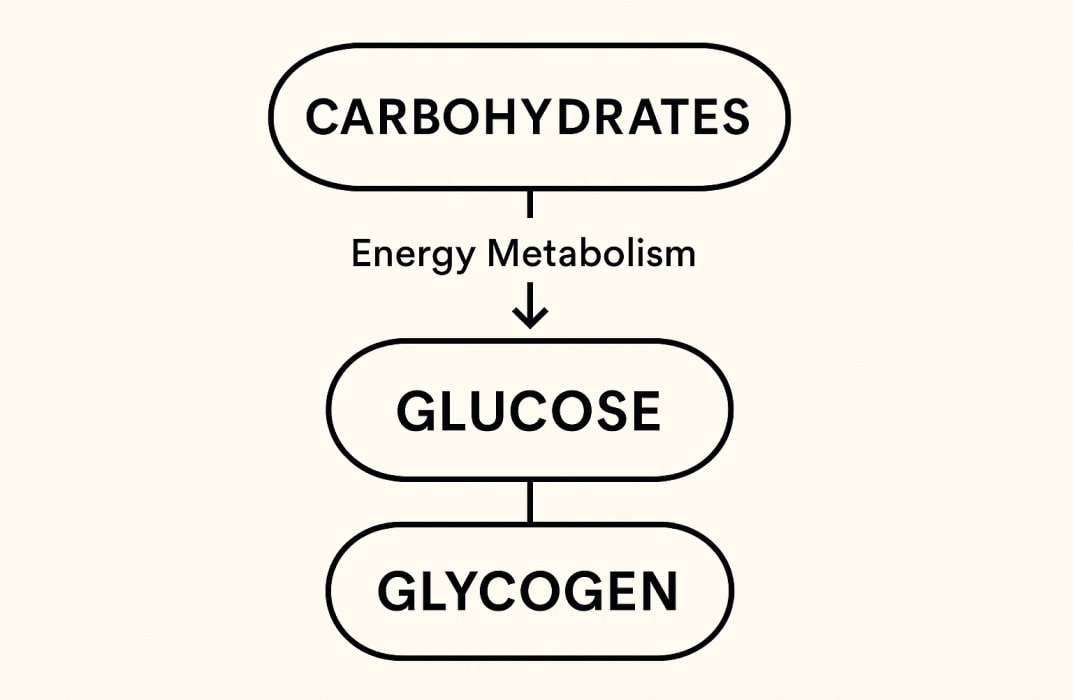Are you preparing for a marathon, triathlon, or any endurance event that will push your body to its limits?
If so, you’ve probably heard about carbohydrate loading, also known as carb loading or carbo loading. This nutritional strategy, including proper carb intake, has become a cornerstone practice for endurance athletes looking to maximize their performance during long-duration events.
But what exactly is carbohydrate loading? How does it work? And is it right for you?
In this comprehensive guide on sports nutrition , we’ll explore everything you need to know about this powerful nutritional approach that could make the difference between hitting the wall and crossing the finish line strong.
What is Carbohydrate Loading?
Carbohydrate loading (also called carb loading or carbo loading) is a nutritional strategy used by athletes to maximize the storage of glycogen (the body’s stored form of carbohydrates) in muscles and liver before a prolonged endurance event. This technique, often detailed in a carb loading plan, involves adjusting both diet and exercise for a period of 1-6 days before competition to significantly increase glycogen stores above normal levels.
In simple terms, carbohydrate loading in a sentence would be:
“The marathon runner practiced carbohydrate loading by increasing her pasta and bread intake while reducing training intensity during the three days before her race.”
The fundamental principle behind CHO loading (another term for carbohydrate loading) is straightforward: your body can only store a limited amount of glycogen, which serves as the primary fuel source during moderate to high-intensity exercise.
By strategically increasing carbohydrate intake and modifying exercise, you can temporarily boost these stores beyond their normal capacity, providing additional energy reserves for exercise performance during endurance activities.
The Science Behind Carbohydrate Loading

To understand why carb loading works, we need to look at how your body uses energy during exercise:
How Your Body Uses Carbohydrates During Exercise
Carbohydrates are one of your body’s primary fuel sources, especially during moderate to high-intensity exercise. When you consume carbs, your body breaks them down into glucose, which can be:
- Used immediately for energy
- Stored as glycogen in your muscles and liver
- Converted to fat if consumed in excess
During exercise, especially at higher intensities, your body primarily relies on glycogen stores to fuel your muscles. However, these stores are limited—typically enough to fuel about 90-120 minutes of moderate to high-intensity exercise.
Once glycogen stores become depleted, your performance significantly decreases, often referred to as “hitting the wall” or “bonking.”
Also read: Plant-Based Diets for Athletes
Glycogen Supersaturation
Carbohydrate loading works by creating what scientists call “glycogen supersaturation” in your muscles, thereby increasing your primary energy source for endurance activities. Through specific dietary and exercise protocols, you can increase muscle glycogen concentrations by approximately 50-100% above normal levels.
This supersaturation doesn’t happen under normal conditions because your body typically maintains a homeostatic balance.
However, by manipulating both exercise and diet, you can temporarily override this balance and store extra glycogen for use during competition.
When to Carb Load: Timing Is Everything
Knowing when to carb load is crucial for maximizing its benefits. Carbohydrate loading is most effective for understanding how much carbohydrate to consume before an event :
- Endurance events lasting longer than 90 minutes
- High-intensity intermittent sports events lasting more than 60 minutes
- Multi-day competitions or tournaments
For shorter events, traditional carb loading may not be necessary or beneficial. Here’s a general guideline on when to implement carb loading based on your event:
The timing of carb loading before your event is equally important. Most modern protocols recommend beginning your carb loading phase 36-48 hours before your event, though some traditional methods may start up to 6 days prior.
How to Carb Load: Proven Strategies
There are several approaches to carbohydrate loading, with protocols evolving significantly since the strategy was first developed in the 1960s. Here are the most common and effective carb loading strategies:
The Classic 6-Day Protocol
The original carbohydrate loading protocol developed in the 1960s followed this structure:
Days 1-3 (Depletion Phase):
- Low carbohydrate diet (5-15% of calories or about 100g per day)
- High-intensity exercise to deplete glycogen stores
Days 4-6 (Loading Phase):
- High carbohydrate diet (70%+ of calories or about 500g+ per day)
- Reduced exercise intensity and volume
While this approach was once considered the gold standard, research has shown that the depletion phase may not be necessary to achieve optimal glycogen storage.
The Modern 2-3 Day Protocol
Current research supports a more practical approach:
36-48 hours before event:
- Consume 10-12g of carbohydrates per kg of body weight daily
- Reduce exercise volume and intensity
- Focus on familiar, easily digestible carbohydrates
For example, a 70kg (154lb) athlete would aim to consume approximately 700-840g of carbohydrates per day during this loading phase.
The Rapid Loading Protocol
For athletes who need to carb load quickly or didn’t plan ahead:
24 hours before event:
- Consume 10g of carbohydrates per kg of body weight
- Complete rest or very light activity only
- Focus on liquid carbohydrates if solid food causes digestive discomfort
Research has shown that even this short protocol can significantly increase muscle glycogen stores in trained athletes without leading to gastrointestinal discomfort .
Best Foods for Carb Loading
Choosing the right foods for carbohydrate loading can make the difference between a successful strategy and one that leaves you feeling bloated or uncomfortable on race day. Here are some of the best foods for carb loading:
High-Carb, Low-Fiber Options
During carb loading, especially in the 24-48 hours before your event, focus on easily digestible carbohydrates that are less likely to cause gastrointestinal distress:
- White pasta and rice
- White bread, bagels, and English muffins
- Pancakes with maple syrup
- Sports drinks and fruit juices
- Ripe bananas and canned fruits
- Low-fat yogurt with honey
- Pretzels and crackers
- Potatoes (white and sweet)
Sample Carb Loading Menu
Here’s what a day of carb loading might look like for a 70kg athlete aiming for 700g of carbohydrates:
Breakfast:
- 2 cups of cooked oatmeal (60g carbs)
- 1 large banana (30g carbs)
- 2 tablespoons honey (30g carbs)
- 1 cup orange juice (25g carbs)
- Total: 145g carbs
Mid-Morning Snack:
- 1 bagel with 2 tablespoons jam (60g carbs)
- 1 sports drink (50g carbs)
- Total: 110g carbs
Lunch:
- 2 cups cooked pasta (80g carbs)
- 1 cup tomato sauce (20g carbs)
- 2 slices garlic bread (30g carbs)
- 1 cup apple juice (30g carbs)
- Total: 160g carbs
Afternoon Snack:
- 1 large baked potato (50g carbs)
- 1 energy bar (40g carbs)
- 1 cup chocolate milk (25g carbs)
- Total: 115g carbs
Dinner:
- 2 cups white rice (90g carbs)
- 1 cup cooked carrots (12g carbs)
- 1 dinner roll with honey (25g carbs)
- 1 cup fruit sorbet (40g carbs)
- Total: 167g carbs
Evening Snack:
- 1 cup cereal with low-fat milk (45g carbs)
- 1 cup grape juice (40g carbs)
- Total: 85g carbs
Daily Total: Approximately 782g carbohydrates
Carb Loading for Different Types of Athletes

While carbohydrate loading is most commonly associated with endurance events, it can benefit various athletic pursuits when properly implemented, avoiding the intake of too much fat that could hinder performance .
Carb Loading for Runners and Cyclists
Endurance runners and cyclists competing in events lasting over 90 minutes can see significant performance benefits from carb loading. Research shows properly executed carbohydrate loading can improve athletic performance and endurance performance by 2-3% in events lasting more than 90 minutes.
For these athletes, focusing on both quantity and timing of carbohydrate intake is crucial. Aim for 10-12g of carbs per kg of body weight for 36-48 hours before the event, while tapering exercise volume.
Carb Loading for Team Sports
Athletes in team sports like soccer that involve prolonged high-intensity intermittent exercise can also benefit from carbohydrate loading. Research has shown that soccer players who followed a high-carbohydrate diet performed 30% more high-intensity running during matches compared to when they followed a low-carbohydrate diet.
For team sport athletes, carb loading should be implemented before tournaments or consecutive game days rather than for every match.
Carb Loading for Bodybuilding
Carb loading in bodybuilding serves a different purpose than in endurance sports. Bodybuilders often use carb loading (sometimes called “carb cycling”) to incorporate healthy fats into their diet before competitions.
- Fill out muscles for a more aesthetic appearance before competitions
- Replenish glycogen stores after depletion phases
- Manipulate water retention for visual effects
The bodybuilding approach typically involves a depletion phase followed by a strategic loading phase, often with careful attention to water intake and sodium levels.
Common Mistakes and How to Avoid Them
Even with the best intentions, many athletes make mistakes when implementing carbohydrate loading. Here are the most common pitfalls, including the overconsumption of high fiber energy bars, and how to avoid them:
1. Carb Loading When You Don’t Need To
Not every athletic event requires carbohydrate loading. For activities lasting less than 60-90 minutes, traditional carb loading may not provide any performance benefits and could lead to unnecessary weight gain from excess calories; therefore, you should avoid high fat intake during this period.
Solution: Reserve carb loading for endurance events lasting longer than 90 minutes or high-intensity intermittent activities exceeding 60 minutes.
2. Consuming the Wrong Amount of Carbohydrates
Many athletes either under-consume carbohydrates (limiting the benefits) or over-consume (leading to digestive issues and excess calories).
Solution: Calculate your specific carbohydrate needs based on body weight. For most athletes, 10-12g per kg of body weight is appropriate during the loading phase. Track your intake, including adequate protein levels, using a food diary or app to ensure you’re hitting your targets.
3. Eating Too Much Fiber
High-fiber foods can cause gastrointestinal distress during carb loading, especially as you approach competition day.
Solution: Gradually reduce fiber intake as you get closer to your event. In the final 24-48 hours, focus on low-residue, easily digestible carbohydrate sources.
4. Drastically Changing Your Diet
Introducing new foods during carb loading can lead to digestive issues or food sensitivities at the worst possible time.
Solution: Practice your carb loading strategy during training to identify which foods work best for your body. Stick with familiar foods, especially in the 24 hours before competition.
5. Neglecting Hydration
Proper glycogen storage requires adequate hydration, as each gram of glycogen is stored with approximately 3 grams of water.
Solution: Increase fluid intake during carb loading, aiming for clear or light yellow urine as an indicator of good hydration status.
The Benefits of Carbohydrate Loading

When properly implemented, carbohydrate loading offers several significant benefits for athletes:
1. Extended Endurance
The primary benefit of carb loading is the ability to exercise at moderate to high intensities for longer periods before exhaustion. Research indicates that carb loading can improve endurance performance by 2-3% in events lasting more than 90 minutes.
2. Delayed Fatigue
With increased glycogen stores, your body can postpone the point at which it must rely heavily on fat oxidation for energy, delaying the onset of fatigue and maintaining higher exercise intensities for longer.
3. Improved Mental Function
Glycogen isn’t just stored in muscles—it’s also stored in the liver and can help maintain blood glucose levels. This helps preserve cognitive function during prolonged exercise, potentially improving decision-making and reaction times in the later stages of competition.
4. Enhanced Recovery
Athletes participating in multi-day events or tournaments can use strategic carbohydrate loading between competitions to replenish glycogen stores more completely, enhancing recovery and subsequent performance.
5. Psychological Confidence
For many athletes, successfully completing a carb loading protocol provides psychological benefits through increased confidence, especially when they include simple sugars in their diet, reducing anxiety about “hitting the wall” during competition.
Carbohydrate Loading in a Sentence: Real-World Examples
To better understand how carbohydrate loading works in practice, here are some examples of carbohydrate loading in a sentence from real athletes:
- “The triathlete followed a strict carbohydrate loading protocol for three days before the Ironman, consuming primarily pasta, rice, and sports drinks while reducing training volume.”
- “After bonking in her previous marathon, Sarah implemented a carbohydrate loading strategy that included 10g of carbs per kg of body weight for 48 hours before race day.”
- “The professional cycling team’s nutritionist designed a carbohydrate loading plan that gradually increased CHO intake as the Tour de France approached.”
- “The soccer team practiced carbohydrate loading before their tournament weekend to ensure optimal glycogen stores for multiple matches.”
- “Despite feeling uncomfortably full, the ultramarathon runner continued his carbohydrate loading regimen, knowing the stored glycogen would be crucial during the latter stages of the 100-mile race.”
Is Carb Loading Right for You?
While carbohydrate loading can be highly effective, it’s not necessary or beneficial for everyone. Consider these factors when deciding if carb loading is right for you:
Who Should Consider Carb Loading:
- Endurance athletes competing in events lasting 90+ minutes
- Team sport athletes during tournament play with multiple games
- Ultra-endurance competitors (marathons, triathlons, century rides)
- Athletes competing at high intensities for 60+ minutes
Who Probably Doesn’t Need Carb Loading:
- Recreational exercisers working out less than 60 minutes
- Strength and power athletes (weightlifters, sprinters)
- Athletes in weight-class sports trying to make weight
- Those with certain medical conditions (consult healthcare provider)
The decision to carb load should be based on your specific event demands, training status, and individual response to different nutritional strategies.
Maximizing Your Performance Through Carbohydrate Loading
Carbohydrate loading is a powerful nutritional strategy that, when properly implemented, can significantly enhance performance in endurance exercise and prolonged high-intensity events. By understanding the science behind glycogen storage, following proven loading protocols, and avoiding common mistakes, you can effectively boost your body’s energy reserves for competition.
Remember that successful carbohydrate loading requires planning and practice. Don’t try a new protocol for the first time before an important event—test your approach during training to determine how your body responds and make adjustments accordingly.
Whether you’re a marathon runner, triathlete, cyclist, or team sport athlete, strategic carbohydrate loading could be the nutritional edge that helps you perform at your best when it matters most. By combining this approach with proper training, hydration, and race-day nutrition, you’ll be well-equipped to achieve your athletic goals and reach new performance heights.
92% trainers worldwide gave us 5 stars
Talk to your dedicated success manager and launch your branded fitness app during the demo in minutes.
Start your paid subscription for $79 FREE





%20to%20Become%20a%20Certified%20Personal%20Trainer-min.jpg)





